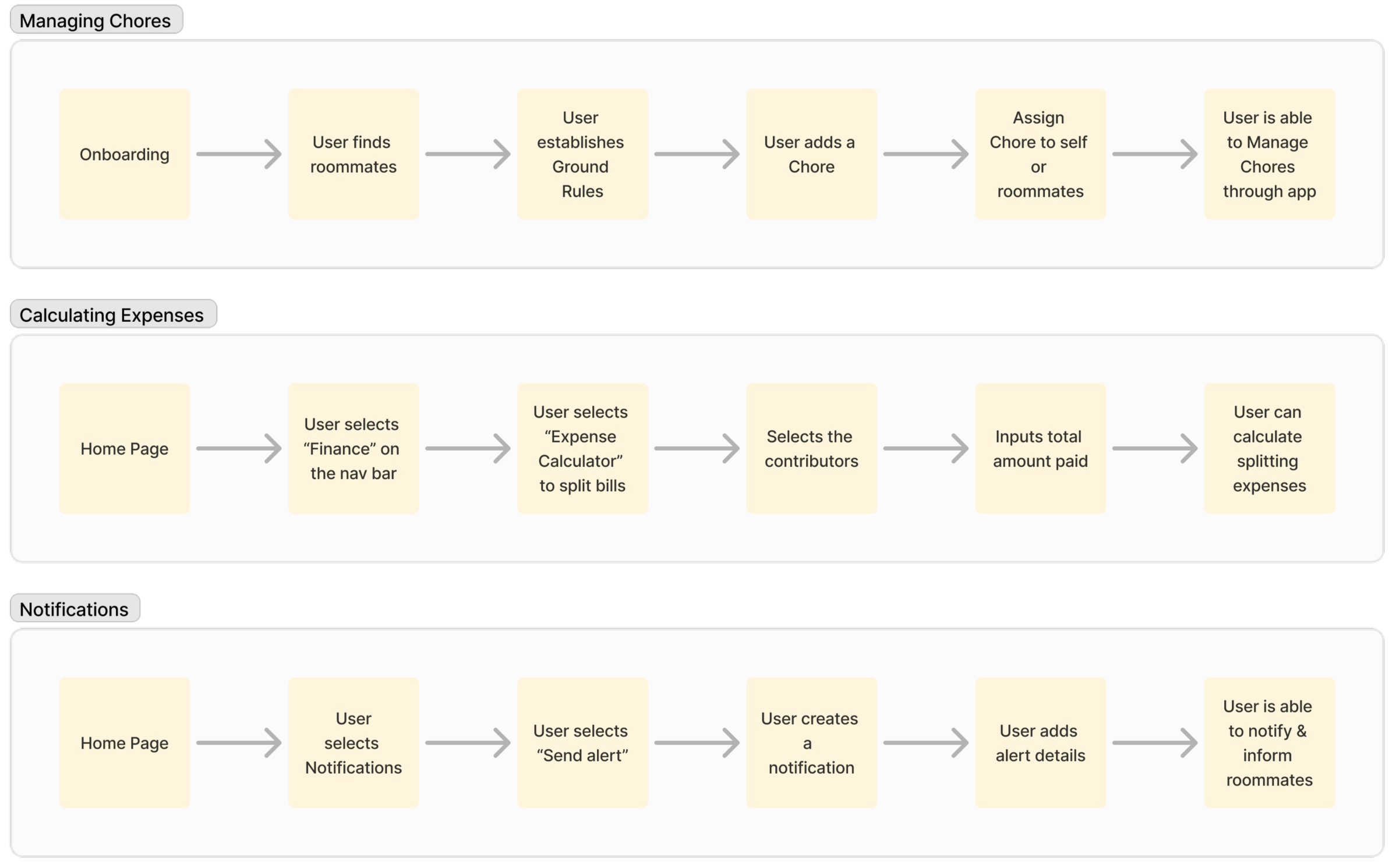
Routeam
Living with roommates in college can be fun, but coordinating chores and managing finances is not always easy. Here’s how we turned everyday chaos into a collaborative solution.
Overview
We addressed the common challenges of shared responsibilities and finances, designing a solution that simplified coordination, improved accountability, and made managing daily tasks more seamless for college roommates.
TIMELINE: 10 weeks
TOOLS: Figma & Figjam
PLATFORM: Responsive Mobile App
CLIENT: IN4MATX 148
TEAM: 4 students (Design)
MY ROLE: Lead Designer
Routeam
We embarked on an extensive design process to address the communication challenges among college students living together.
Our approach was multifaceted, incorporating:
Competitive analysis, user research, persona development, storyboarding, and the creation of prototypes at various levels of fidelity.
"How might we improve communication about household responsibilities for students living together so that residents can better manage their finances and chores?"
Problem Statement:
Competitive Analysis
I organized a competitive analysis to understand the existing solutions in the market.
Market Solutions:
Analyzing several existing apps and platforms aimed at shared living arrangements (e.g., Splitwise, Roomie, and others).
Found that most apps focused on either financial management or basic task coordination.
Discovering User Needs
Interviews showed that early ground rules eased responsibilities. While some avoided talks about chores, money, and noise, others shared schedules openly. Our analysis revealed key roommate pain points, informing task flows for bills, chores, and notifications.
Affinity Diagram
Scenario Task Flows
Straight from the Source
“I love my roommates, but since I feel like I’m a friend more than a roommate, I feel a little lame bringing up the chores and finances, especially since I’m a generally non-confrontational person. It would help.”
— Interview Participant
“This app would be especially useful during the beginnings of moving in, when everyone isn’t as familiar or comfortable with each other at the start… it’s a great jumping off point. I would use it during move in weeks.”
— Interview Participant
“I feel bad because I’m the only one who’s out of the house the most, so I feel bad that I might not be contributing to chores as much as the others. I would love to have a way to be notified about something like that.”
— Interview Participant
User Personas
Sketches & Storyboards
The research findings were synthesized using affinity diagrams to organize and categorize collected data, revealing patterns and themes. These insights guided my design direction and feature prioritization based on user needs. My design process involved creating wireframes and prototypes at different fidelity levels seen here!
Storyboard
Mid Fidelity
Low Fidelity
Page Flow of Routeam
Intuitive Flow
My page flow visually represents the structure and navigation we designed to streamline household management.
Home Screen: Access Settings, Finances, Chores, and Notifications.
Settings: Customize roles, adjust preferences, and edit ground rules.
Finances: Manage payments, budgeting, and shopping lists.
Chores: Add, assign, and track tasks with flexible options.
Design Priorities
Clear Pathways: Makes decision-making simple for users.
My Design Philosophy: Simplifying complex tasks while offering flexibility.
Data-Driven Design: Task flows informed accessible features and use cases.
Prototyping: Sketches, storyboards, and wireframes helped refine the process.
Consolidated Screen Flow
My Contributions:
I led my team through a user-centered design process, using personas, storyboards, and user research to uncover our users’ needs.
While my teammates focused more on UX research, I took the lead on prototyping and design, bringing our ideas to life.
Prototyping Highlights:
Developing and refining prototypes from low-fidelity sketches to interactive mockups, iterating based on user feedback.
Effectively met user needs, solved key problems, and illustrated how our collaborative process translated ideas into actionable solutions.
Key Takeaways
Reflection
-
This project showcased not only my design process and problem-solving skills but also underscored the collaborative nature of UX design for me!
Through close collaboration with my team, we delved into user research, prototyping, and iterative design to create a solution tailored to the needs of our target demographic.
Our team had a lot of ideas of where to take this app, so we learned how to communicate our ideas, schedule meetings to work on deliverables, and manage our time efficiently.
Being mindful of what we needed to accomplish instead of what we wanted to accomplish helped us keep our goals in mind.
-
Throughout this process, I gained proficiency in conducting user interviews, a cornerstone of user-centered design, which provided invaluable firsthand insight into user needs, preferences, and pain points.
Our process naturally followed the Double Diamond framework: we began by diverging to explore a wide range of possibilities and user frustrations, then converged to define our key problem spaces.
We explored and tested potential solutions. Time constraints required us to carefully prioritize features. While we originally explored ideas like gamifying task completion, we ultimately focused on delivering a strong core experience.
I became adept at implementing design changes based on user feedback and iterative testing. Each round of refinement moved us closer to a more intuitive and user-aligned final product, a reflection of the iterative nature of the Double Diamond process.
-
I had a great experience working with my group and I found that I worked well under the deadlines that the professors gave me.
Out of my entire team, I had the most experience with Figma and was able to lead the team’s design process. It came in handy to have experience in design software, and I gained more by being able to teach it to others.
I do wish that we had a larger audience to conduct a survey to gain statistics to base our work off of, instead of having to conduct more personal interviews just to gain some experience in doing statistical analysis.
However, we were still able to gain valuable information from our research. My main takeaway from this entire project was solidifying my knowledge of a structured design process, communicating ideas and most importantly, working with a team.













